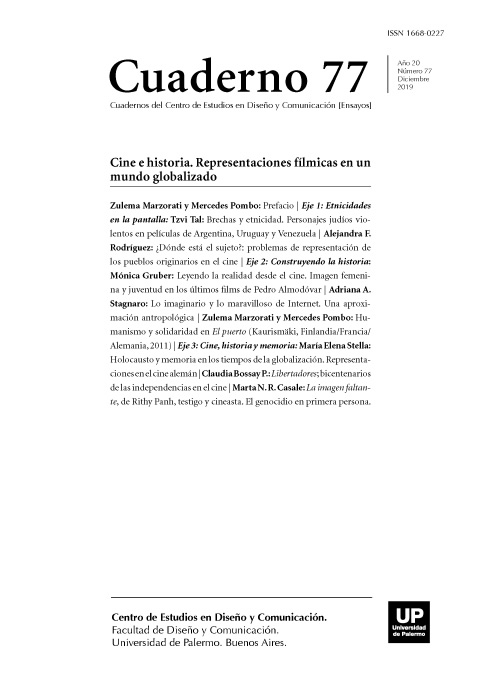Libertadores; bicentenarios de las independencias en el cine
Resumo
Durante os bicentenários das independências em Latino América se gestou uma ampla produção audiovisual criada por e para a televisão e o cinema, que refletia sobre as independências e as colônias. Entre esta vasta produção se destaca a coleção Libertadores, desenhada para estar composta por oito cintas de ficção histórica que narrariam histórias épicas de líderes independentistas de diferentes países latino americanos: Argentina, Brasil, Chile, Cuba, México, Peru, Uruguai e Venezuela. Na primeira etapa, esta coleção foi coproduzida pela produtora espanhola Wanda Films, junto com Lusa Films e a empresa de rádio e televisão pública espanhola TVE, junto com produtoras de cinema e televisão locais de Latino Amé- rica, tanto privadas como públicas. O projeto enfrentou dificuldades para sua concreção e sofreu um hiato na metade do processo de produção. Foi retomada em parte, estreando uma obra recém em 2017, e cancelando a última das obras. A coleção Libertadores se caracteriza como “cinema de cruzamentos”: nacionais e internacionais, de diferentes meios e com diferentes modos de criação e reflexão visual, respondendo a todas estas diferentes idiossincrasias. A partir da análise de sete obras, este trabalho avalia que elementos dos passados fundacionais das repúblicas latino-americanas se decidiram destacar durante as celebrações dos bicentenários das independências, refletindo sobre o presente dos períodos de produ- ção. Destacam-se particularmente a radiografia de modos e estados de produção das obras em Latino América; a representação das dinâmicas entre o império espanhol e os revolucionários e vitoriosos latino- americanistas; as manifestações de autodeterminação que aparecem nas obras, e, finalmente, os aspectos das individualidades dos libertadores. Este estudo procura identificar como estas historofotias independentistas convertem-se numa proposta válida para entender a identidade dos povos do bicentenário no mundo globalizado.
Referências
Barceló Vázquez, L. [S/F]. “Arquitecto de fantasías”. En Radio Rebelde http://www.cubacine.cult.cu/sitios/ficcion/muescoment.php?CM=050908 [revisado diciembre 2017].
Bossay, C. (2014) “El niño rojo (Ricardo Larraín, 2013)”, En El Agente cine, octubre 2014. En http://elagentecine.cl/2014/10/23/el-nino-rojo-ricardo-larrain-2013/
Bowen, A. (2017) Entrevista personal. 15 diciembre 2017.
De España, R. (2002) Las sombras del encuentro: España y América, cuatro siglos de historia a través del cine. Diputación de Badajoz.
Gordon, R. (2009). Cannibalizing the Colony: Cinematic Adaptations of Colonial Literature in Mexico and Brazil. Purdue University Press.
Lorite, A. (2011). “Los héroes libertadores llegan a las pantallas de América Latina” https://elpais.com/cultura/2011/03/10/actualidad/1299711612_850215.html [revisado octubre 2017].
Morales, J. M. (2018) Entrevista personal. 01 marzo 2018.
Pagés, A. (2011). “A veces las películas son fascinantes por un hecho azaroso”. Analecta Literaria. http://testimoniosautorizados.blogspot.cl/2013/03/leandro-ipina.html [Revisado octubre 2017].
Rosenstone, R. (1995). Visions of The Past: The Challenge of Film to Our Idea of History. Cambridge: Harvard.
RTVE.es (2009). “TVE ‘baja de la estatua’ a los libertadores latinoamericanos en su bicentenario” http://www.rtve.es/noticias/20090921/tve-baja-estatua-libertadoreslatinoamericanos-su-bicentenario/293324.shtml [revisado octubre 2017]
Vertele.es (2009). “Rodolfo Sancho será uno de los tres “Libertadores” de TVE” http://vertele.eldiario.es/verteletv/actualidad/Rodolfo-Sancho-LibertadoresTVE_0_1065193490.html [revisado octubre 2017].
Wanda Films (2010). “Libertadores. Una colección de 8 películas sobre los héroes de la independencia de América Latina”. España.
Zweig, N. (2013). “Los Libertadores as Crossover Cinema”. En Crossover Cinema. Crosscultural Film from Production to Recepction. Routledge.
González, R. (2013) “Vida de Simón Bolívar inspira la cinta más cara del cine latinoamericano” en La Tercera, 11/09/2013. Disponible en: http://www.latercera.com/noticia/vida-de-simon-bolivar-inspirala-cinta-mas-cara-del-cine-latinoamericano/ [Revisado octubre 2017].
Los autores/as que publiquen en esta revista ceden los derechos de autor y de publicación a "Cuadernos del Centro de Estudios de Diseño y Comunicación", Aceptando el registro de su trabajo bajo una licencia de atribución de Creative Commons, que permite a terceros utilizar lo publicado siempre que de el crédito pertinente a los autores y a esta revista.


